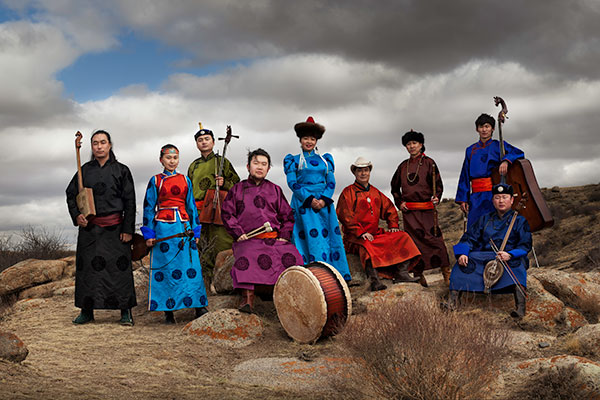
The band Anda Union reaches out to global audiences with its new interpretation of traditional Mongolian music. [Photo provided to China Daily]
At Settle Victoria Hall in England, Chinese performers in long colorful robes and leather boots recently enthralled an audience, members of which had seldom heard the sounds of the morin khuur (horse-head fiddle) and such other indigenous instruments before. Showcasing the traditional khoomei, or throat-singing, musicians brought alive the magic of the grasslands and the mountains.
During the hourlong concert, the band from the Inner Mongolia autonomous region led the audience through a mixture of nomadic melodies, as part of its UK tour that started on Jan 26.
Anda Union, the band from Hohhot, capital of Inner Mongolia, performed 23 concerts in Glasgow, Liverpool and Oxford, among other cities. The tour will end on Feb 19.
“It has been raining since we started our tour in the United Kingdom. Some people may not like the rain but we enjoy it very much. The smell of the grass reminds us of our home. We love being close to nature,” says Nars, the lead musician, who grew up in the Horqin grasslands of Inner Mongolia with his herder grandparents.
Since the band’s birth in 2001, the musicians’ mission has been to find inspiration from old and forgotten songs while creating a new form of music.
One of their songs, The Legend of the Swan Brothers, is based on a Mongolian song, which tells the story of a local folk hero similar to Robin Hood, stealing from the rich to help the poor.
“We all grew up with legends of Genghis Khan, Mongol tribespeople and many other folk tales about love, brotherhood and courage. They are our wealth,” says Nars, 34.
Since most of the tales have no written form, the band members sought help from their parents and grandparents to learn the melodies and lyrics.
Nars learned to play the horse-head fiddle from his grandfather.
At age 12, he went to Chifeng to study music, where he met some of Anda Union’s future members. The rest of the band came from Hohhot after Nars joined the Inner Mongolian Music and Dance Troupe.
The band’s name, Anda, is derived from the Mongolian word for “brotherhood”.
Most of the members are skilled in khoomei singing. Each member also plays a traditional instrument or does vocal music. Uni plays the tobshur, a two-stringed Mongolian lute; Chinggel plays the moadin chor, a Mongolian flute made from a reed; and Tsetsegmaa and Biligbaatar are masters of urtyn duu, or the long song, a style of singing which stretches sentences over minutes.
In 2006, the band won the first prize for ethnic music at CCTV’s Youth Singing Competition, which gave it opportunities at the national level.
The band’s performance at an arts festival in Shanghai in 2006 caught the attention of Tim Pearce, a UK filmmaker, who became the band’s manager three years later.
“It doesn’t matter that people do not understand the language. Their music is truly universal, and there is no other band presenting Mongolian music as they are. They have the greatest variety of songs and take people on a wonderful musical journey,” says Pearce, who has toured with the band in the United States, UK, Australia and New Zealand.
In 2009, Pearce traveled with the band to the grasslands of Inner Mongolia, where they discovered old songs and a rapidly changing social environment.
After three months of filming and a year of editing, the documentary, Anda Union From the Steppes to the City, was released.
“The lifestyle of Mongolian people has changed. For example, people ride motorcycles on grasslands rather than riding horses. But we are proud of our nomadic culture,” says Nars, who runs a music school in Hohhot, teaching young people to play various instruments.
Band member and vocalist Saihanniya runs a Mongolian bar in Hohhot that promotes Mongolian music.
“We especially want to catch the attention of young people, who more likely listen to hip-hop, pop and rock,” Nars says.
“What we have done is just a drop in the ocean since Mongolian music is a huge treasure that needs to be rediscovered and preserved.”
